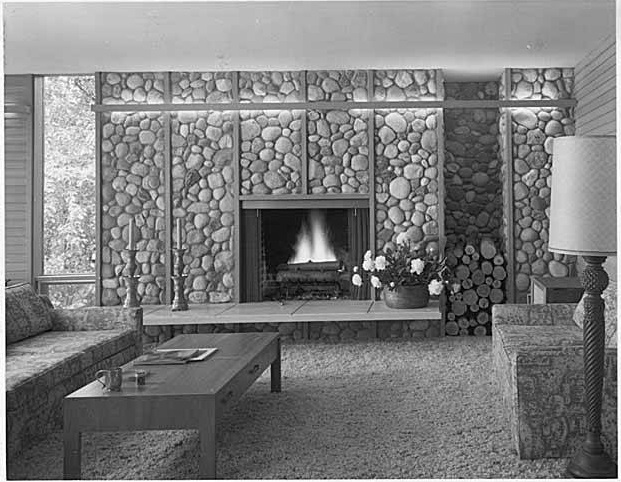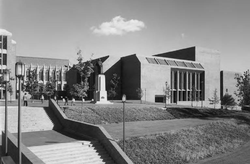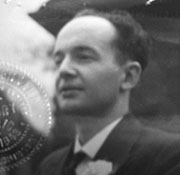
You’re aware of his work. Or at least, if you’ve lived in or visited Seattle, you’ve probably been in or by a Paul Hayden Kirk building. Paul is one of the architects responsible for doing more than just bringing modernism to the Seattle area. He helped refine the style to suit the region.
Paul Hayden Kirk was a local. He graduated from UW before World War II, and was probably excused from service because polio left him with partial-paralysis in one arm. Like many new architects, his career started with houses. Watch the listings and occasionally one of his houses will come onto the market.

Throughout the war, architecture adapted to the economy and lack of materials. Resourcefulness ruled over aesthetics. Pragmatism and imposed minimalism encouraged modern design approaches. His style started with Modernist which evolved into the International Style: more rectilinear, including flat roofs; and incorporating more windows. And yet, he felt the style didn’t match the Puget Sound’s character. International was “an architecture which has been imposed on the land by man.” Eventually, his style emphasized working with the land – a local approach that is so taken for granted that it is hard to recognize how revolutionary it was.
Pacific Northwest Style is recognized as “bringing nature indoors.” It wasn’t just about lots of windows letting in views and light. Proper siting to properly sit on the land respected the land. Paul also incorporated the use of wood, and adding detailing to the structure. Support beams weren’t to be hidden, but exposed to tie the building to the land.

While he started with houses, he also became known for the important niche of buildings for clinics and doctor’s offices, a unique set of requirements and needs frequently overlooked. Your doctor’s visit might be an opportunity for a design tour.

Houses and offices are important, but they’re not as visible as his larger works. Wander the University of Washington campus. Meany Hall and Odegaard Undergraduate Library; two buildings for the School of Business, Ballmer Hall and MacKenzie Hall; two dormitories, Haggott and McMahon; as well as the award-winning Faculty Club all were part of his creative workload. The Faculty Club was awarded for its use of steel inside and out, providing a feeling of permanence, something appropriate for a building holding tenured professors. Thanks to a good location, Haggett Hall was designed to open to views of Lake Washington and the mountains. The hall also included innovative floor plans based on hexagonal rooms, changing the convention of four walls with maybe one window to six walls with two angled windows. More windows, more nature inside.

Paul was also in the right place at the right time to contribute to another major Seattle landmark: Seattle Center. Theater attendees may be familiar with Intiman Theater’s home. Nearby is the Exhibition Center, another of his projects. The largest structure may be the easiest to overlook, the Mercer garage. Architecture isn’t always about flash. Sometimes function dominates.

There are a variety of other buildings in the Seattle area: several churches, Church of the Brethren, Japanese Presbyterian Church, Lakewood Community Church, and University Unitarian Church; the Magnolia branch of the Seattle Public Library; and Norwood Village in Bellevue. Each unique, but within his style.
Norwood Village included one of his research houses. The Wood Products Research House explored the use of plywood and laminated beams. There, he also explored more innovative shapes, replacing rectilinear roofs with self-supporting hyperbolic paraboloids. In 1956, the industry was exploring ways to incorporate the new sweep of electrical appliances heading into suburbia. In response, he designed the Electri-living House. Built in Medina, one of the design criteria was tract-home developers could replicate the design.
Because of Paul Kirk’s emphasis on nature, it is worth noting two of his designs that were in less urban settings: Camp Nor’wester in the San Juans, and the Guest House at Bloedel Reserve on Bainbridge Island. When feasible, he used local materials like cedar, and local contractors who knew the land. The less urban the setting, the more likely the structure would relax to include rough hewn, but natural, materials.

Paul Hayden Kirk is worth noting for helping develop and define PNW Modernism; but he is also worth studying to see how his designs evolved. It may have started with the International Modern Style, but incorporated Pacific Rim influences like Japanese interiors and exteriors design, and local methods and materials into a design that fit the local culture, and the local land in ways that persist to exist today. Take a tour of UW, or Seattle Center, or the real estate listings, or maybe your doctor’s office as a way to appreciate his contribution.